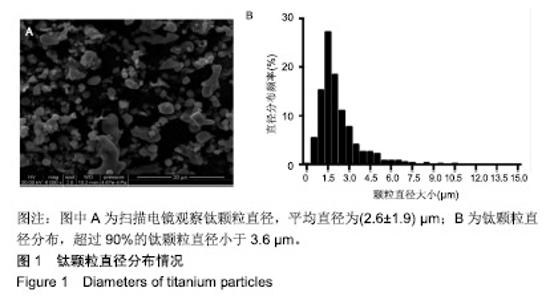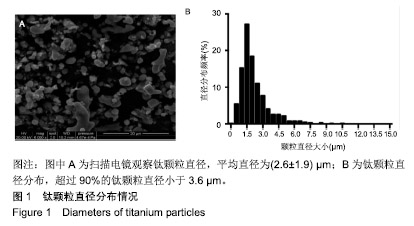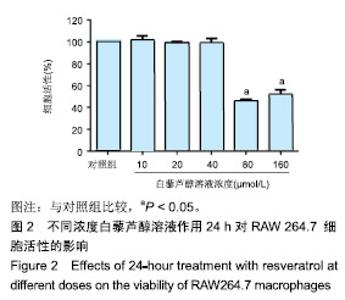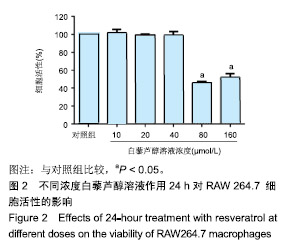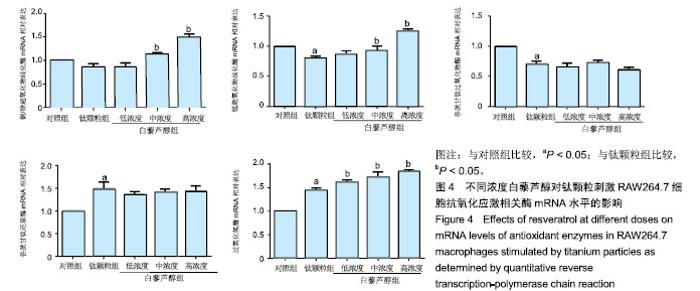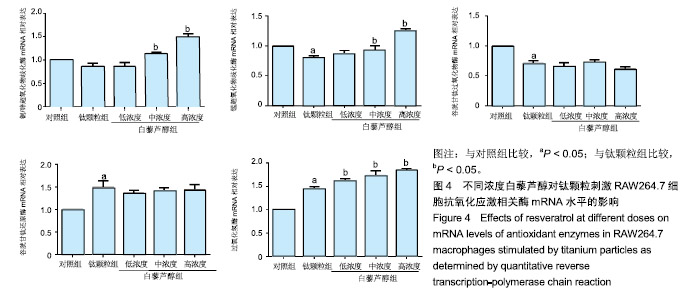Chinese Journal of Tissue Engineering Research ›› 2019, Vol. 23 ›› Issue (26): 4115-4120.doi: 10.3969/j.issn.2095-4344.1398
Previous Articles Next Articles
Resveratrol reduces tumor nuclear factor-α expression in wear-particle-treated macrophages by regulating the level of intracellular oxidative stress
- Department of Bone and Joint Diseases, Shenzhen Baoan District People's Hospital, Shenzhen 518101, Guangdong Province, China
-
Received:2019-05-04 -
Contact:Liang Jinfeng, Master, Associate chief physician, Department of Bone and Joint Diseases, Shenzhen Baoan District People's Hospital, Shenzhen 518101, Guangdong Province, China -
About author:Liu Wenhua, Master, Associate chief physician, Department of Bone and Joint Diseases, Shenzhen Baoan District People's Hospital, Shenzhen 518101, Guangdong Province, China
CLC Number:
Cite this article
Liu Wenhua, Liang Jinfeng, Deng Shaojie. Resveratrol reduces tumor nuclear factor-α expression in wear-particle-treated macrophages by regulating the level of intracellular oxidative stress[J]. Chinese Journal of Tissue Engineering Research, 2019, 23(26): 4115-4120.
share this article
| [1]Thiele K, Perka C, Matziolis G,et al.Current failure mechanisms after knee arthroplasty have changed: polyethylene wear is less common in revision surgery.J Bone Joint Surg Am.2015;97: 715-720.[2]Learmonth ID,Young C,Rorabeck C.The operation of the century: total hip replacement.Lancet. 2007;370(9597):1508-1519.[3]Inacio MCS,Ake CF,Paxton EW,et al.Sex and Risk of Hip Implant Failure Assessing Total Hip Arthroplasty Outcomes in the United States. Jama Intern Med.2013;173(6):435-441.[4]Purdue PE,Koulouvaris P,Potter HG,et al.The cellular and molecular biology of periprosthetic osteolysis.Clin Orthop Relat Res. 2007;454:251-261.[5]Goodman SB,Gibon E,Pajarinen J,et al.Novel biological strategies for treatment of wear particle-induced periprosthetic osteolysis of orthopaedic implants for joint replacement.J R Soc Interface. 2014;11(93):20130962.[6]Baur JA,Sinclair DA.Therapeutic potential of resveratrol: the in vivo evidence.Nat Rev Drug Discov. 2006;5(6):493-506.[7]Tennen RI,Michishita-Kioi E,Chua KF.Finding a Target for Resveratrol. Cell.2012;148:387-389.[8]Diaz-Gerevini GT,Repossi G,Dain A,et al.Beneficial action of resveratrol: How and why? Nutrition.2016;32(2):174-178.[9]Bitterman JL, Chung JH. Metabolic effects of resveratrol: addressing the controversies. Cell Mol Life Sci. 2015;72(8): 1473-88.[10]Momken I,Stevens L,Bergouignan A,et al.Resveratrol prevents the wasting disorders of mechanical unloading by acting as a physical exercise mimetic in the rat.FASEB J. 2011;25(10): 3646-3660.[11]Tresguerres IF,Tamimi F,Eimar H,et al.Resveratrol as anti-aging therapy for age-related bone loss. Rejuv Res.2014;17(5):439-445.[12]Wang HD, Shi YM, Li L, et al.Treatment with resveratrol attenuates sublesional bone loss in spinal cord-injured rats.Br J Pharmacol. 2013;170(4):796-806.[13]Zhao HF, Li XM, Li N,et al.Long-term resveratrol treatment prevents ovariectomy-induced osteopenia in rats without hyperplastic effects on the uterus.Br J Nutr.2014;111(5):836-846.[14]Kinov P, Leithner A, Radl R,et al.Role of free radicals in aseptic loosening of hip arthroplasty. J Orthop Res.2006;24(1):55-62.[15]Suh KT, Chang JW, Jung JS. The role of inducible nitric oxide synthase in aseptic loosening after total hip arthroplasty.J Bone Joint Surg Br.2002;84(5):753-757.[16]Kinov P, Tzoncheva A, Tivchev P. Evidence Linking Elevated Oxidative Stress and Aseptic Loosening of Hip Arthroplasty.Cr Acad Bulg Sci.2010;63:1231-1238.[17]Anderson JM, Rodriguez A, Chang DT. Foreign body reaction to biomaterials. Seminars in Immunology. 2008;20:86-100.[18]Nich C, Takakubo Y, Pajarinen J, et al.Macrophages-Key cells in the response to wear debris from joint replacements. J Biomed Mater Res A.2013;101:3033-3045.[19]Archibeck MJ, Jacobs JJ, Roebuck KA, Glant TT. The basic science of periprosthetic osteolysis. J Bone Joint Surg Am.2000 ; 82a:1478-1489.[20]Ren PG,Irani A,Huang ZN,et al.Continuous Infusion of UHMWPE Particles Induces Increased Bone Macrophages and Osteolysis. Clin Orthop Relat R.2011;469:113-122.[21]Huang ZN,Ma T,Ren PG,et al.Effects of orthopedic polymer particles on chemotaxis of macrophages and mesenchymal stem cells.J Biomed Mater Res A.2010;94a:1264-1269.[22]Yang F, Wu W, Cao L,et al.Pathways of macrophage apoptosis within the interface membrane in aseptic loosening of prostheses. Biomaterials. 2011;32:9159-9167.[23]Pajarinen J Kouri VP,Jamsen E,et al.The response of macrophages to titanium particles is determined by macrophage polarization. Acta Biomater.2013;9(11):9229-9240.[24]Fritton K, Ren PG, Gibon E, et al. Exogenous MC3T3 Preosteoblasts Migrate Systemically and Mitigate the Adverse Effects of Wear Particles.Tissue Eng Pt A.2012;18(23-24): 2559-6257.[25]O'Neill SC,Queally JM,Devitt BM,et al.The role of osteoblasts in peri-prosthetic osteolysis. Bone Joint J.2013;95-B(8):1022-1026.[26]Jiang YP,Jia TH,Gong WM,et al.Titanium particle-challenged osteoblasts promote osteoclastogenesis and osteolysis in a murine model of periprosthestic osteolysis.Acta Biomater. 2013;9: 7564-7572.[27]Ren WP,Markel DC,Schwendener R,et al.Macrophage depletion diminishes implant-wear-induced inflammatory osteolysis in a mouse model. J Biomed Mater Res A. 2008;85(4):1043-1051.[28]Ren PG, Huang ZN, Ma T,et al.Surveillance of systemic trafficking of macrophages induced by UHMWPE particles in nude mice by noninvasive imaging. J Biomed Mater Res A.2010;94(3):706-711.[29]Ren PG, Lee SW, Biswal S, Goodman SB. Systemic trafficking of macrophages induced by bone cement particles in nude mice. Biomaterials.2008;29:4760-4765.[30]Gibon E, Ma T, Ren PG,et al.Selective inhibition of the MCP-1-CCR2 ligand-receptor axis decreases systemic trafficking of macrophages in the presence of UHMWPE particles.J Orthop Res. 2012;30(4):547-553.[31]Mostardi RA, Kovacik MW,Ramsier RD,et al.A comparison of the effects of prosthetic and commercially pure metals on retrieved human fibroblasts: The role of surface elemental composition. Acta Biomater. 2010;6:702-707.[32]Del Buono A,Denaro V,Maffulli N. Genetic susceptibility to aseptic loosening following total hip arthroplasty: a systematic review. Br Med Bull.2012;101:39-55.[33]Gallo J, Mrazek F, Petrek M. Variation in cytokine genes can contribute to severity of acetabular osteolysis and risk for revision in patients with ABG 1 total hip arthroplasty: a genetic association study.BMC Med Genet.2009;10:109. [34]Pearl JI,Ma T,Irani AR,et al.Role of the Toll-like receptor pathway in the recognition of orthopedic implant wear-debris particles. Biomaterials. 2011;32(24):5535-5542.[35]Jamsen E, Kouri VP, Olkkonen J,et al.Characterization of macrophage polarizing cytokines in the aseptic loosening of total hip replacements.J Orthop Res.2014;32:1241-1246.[36]Lambeth JD, Neish AS.Nox Enzymes and New Thinking on Reactive Oxygen: A Double-Edged Sword Revisited. Annu Rev Pathol. 2014;9:119-145.[37]Sareila O, Kelkka T, Pizzolla A, et al. NOX2 Complex-Derived ROS as Immune Regulators. Antioxid Redox Signal.2011;15(8): 2197-2208. [38]Chen W, Li Z, Guo Y, et al. Wear particles promote reactive oxygen species-mediated inflammation via the nicotinamide adenine dinucleotide phosphate oxidase pathway in macrophages surrounding loosened implants.Cell Physiol Biochem.2015;35(5):1857-1867.[39]Chen WS, Li ZQ, Guo Y,et al.Wear Particles Impair Antimicrobial Activity Via Suppression of Reactive Oxygen Species Generation and ERK1/2 Phosphorylation in Activated Macrophages. Inflammation. 2015;38(3):1289-1296.[40]Tsaryk R, Peters K, Barth S,et al.The role of oxidative stress in pro-inflammatory activation of human endothelial cells on Ti6Al4V alloy.Biomaterials.2013;34(33):8075-8085.[41]Samelko L,Caicedo MS,Lim SJ,et al.Cobalt-alloy implant debris induce HIF-1alpha hypoxia associated responses: a mechanism for metal-specific orthopedic implant failure.PLoS One.2013;8: e67127.[42]Raghunathan VK, Devey M,Hawkins S, et al.Influence of particle size and reactive oxygen species on cobalt chrome nanoparticle-mediated genotoxicity. Biomaterials. 2013;34(14): 3559-3570.[43]Hallab NJ, Jacobs JJ. Biologic effects of implant debris. Bull NYU Hosp Jt Dis.2009;67:182-158. |
| [1] | Pei Lili, Sun Guicai, Wang Di. Salvianolic acid B inhibits oxidative damage of bone marrow mesenchymal stem cells and promotes differentiation into cardiomyocytes [J]. Chinese Journal of Tissue Engineering Research, 2021, 25(7): 1032-1036. |
| [2] | Wang Qiufei, Gu Ye, Peng Yuqin, Xue Feng, Ju Rong, Zhu Feng, Wang Yijun, Geng Dechun, Xu Yaozeng. Effect of Wnt/beta-catenin signaling pathway on osteoblasts under the action of wear particles [J]. Chinese Journal of Tissue Engineering Research, 2021, 25(24): 3894-3901. |
| [3] | Luo Anyu, Liu Hanlin, Xie Xiaofei, Huang Chen. Effect of antioxidant mixture on structural degeneration of an osteoarthritis rat model [J]. Chinese Journal of Tissue Engineering Research, 2021, 25(23): 3625-3629. |
| [4] | Cong Renyuan, Yuan Jing, Xia Jinchan, Sun Ying . Effects of baicalin on oxidative stress in BEAS-2B cells stimulated by lipopolysaccharide combined with adenosine triphosphate [J]. Chinese Journal of Tissue Engineering Research, 2021, 25(2): 286-291. |
| [5] | Zhou Yi, Chen Yueping, Zhang Xiaoyun, Lai Yu, Liao Jianzhao, Li Shibin. An exploration on mechanism of Shengyu Decoction in treating osteonecrosis of the femoral head based on network pharmacology [J]. Chinese Journal of Tissue Engineering Research, 2021, 25(17): 2687-2696. |
| [6] | Liu Zige, Liu Xinrui, Li Yan, Song Guorui, Zhang Chen, Chen Desheng. In vitro experiment of tetrandrine on the model of osteolysis induced by wear particles around the prosthesis [J]. Chinese Journal of Tissue Engineering Research, 2021, 25(15): 2358-2363. |
| [7] | Yuan Baohong, Zhao Weishan, Wang Ruotian, Guan Aoran, Wang Yu, Li Ruhong. Bone marrow mesenchymal stem cells from pigs inhibit inflammatory response induced by lipopolysaccharide and improve islet cell dysfunction in pigs [J]. Chinese Journal of Tissue Engineering Research, 2021, 25(13): 1969-1975. |
| [8] | Mao Xin, Yu Limei, Wang Feng. Important role of mesenchymal stem cells in immune tolerance induction in heart transplantation [J]. Chinese Journal of Tissue Engineering Research, 2021, 25(13): 2070-2078. |
| [9] | Zhao Ning, Yu Hongdan, Feng Zhen, Ding Jiayuan, Liu Xuezheng. Salidroside inhibits apoptosis of retinal Müller cells induced by high glucose in rats [J]. Chinese Journal of Tissue Engineering Research, 2021, 25(11): 1664-1669. |
| [10] | Li Junqi, Tian Guangzhao, Chen Mingxue, Wang Hao, Liu Shuyun, Sui Xiang, Huang Jingxiang, Li Ming, Guo Quanyi. Regulatory effect of acellular cartilage extracellular matrix on phenotype of mouse macrophage line [J]. Chinese Journal of Tissue Engineering Research, 2021, 25(10): 1512-1516. |
| [11] | Wan Huazhe, Chai Guangxin, Xiao Xiaoling, Huang Wenying. Effects of phellinus igniarius crude polysaccharides on sporting ability and free radical metabolism of skeletal muscle in mice suffering passive smoking [J]. Chinese Journal of Tissue Engineering Research, 2020, 24(5): 689-693. |
| [12] | Yu Hui, Zhao Yang, Fei Jiayue, Zhang Wenli, Zhao Luosha. Isoliquiritigenin inhibits SETD7 expression against oxidative damage in cardiomyocytes induced by hypoxia/reoxygenation [J]. Chinese Journal of Tissue Engineering Research, 2020, 24(35): 5613-5618. |
| [13] | Lin Yicai, Wu Zhengyuan, Luo Yingli, Yao Jun. Effect of pterostilbene on oxidative stress induced apoptosis in chondrocytes [J]. Chinese Journal of Tissue Engineering Research, 2020, 24(32): 5092-5096. |
| [14] | Bai Zhenjun, Liu Tong, Wang Zirun, Zhang Huiyu, Xu Peng. Effect of “Lumbar Three Needles” on expression of oxidative stress factors in rats with multifidus muscles injury [J]. Chinese Journal of Tissue Engineering Research, 2020, 24(32): 5145-5150. |
| [15] | Tan Jing, Yi Guodong. Protective effects of sulforaphane in a H2O2 induced oxidative stress model of human hepatocytes [J]. Chinese Journal of Tissue Engineering Research, 2020, 24(31): 5052-5056. |
| Viewed | ||||||
|
Full text |
|
|||||
|
Abstract |
|
|||||
